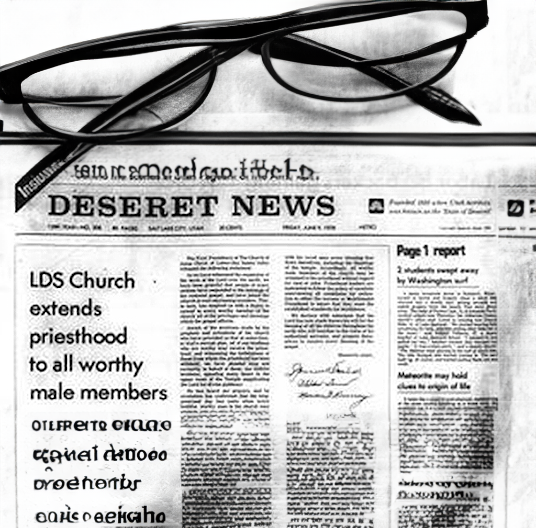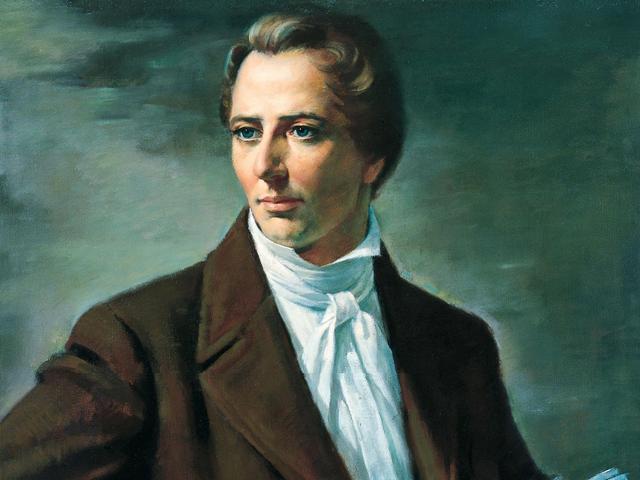
Image from LDS.org
An Individual Struggle of Conscience
Any member of the LDS Church whose conscience has not struggled with the reality that, for more than a century, blacks in Mormonism could not participate equally in Church blessings and opportunities as other races, is a rare creature. Some readers might disagree. Some would argue that if someone is “born into” the LDS faith that this person is, as a result of their heritage, more likely to be “culturally acclimated” on this matter. Perhaps a few individuals could be identified, but in our modern western society where, for decades, racial equality is magnified as a core human value, instances where Church members have not pondered the issue of Mormons and blacks are practically non-existent. This is not to say that some members, in their efforts to understand or rationalize LDS Church history, always draw appropriate conclusions. It only means that there are very few mature, active Church members who haven’t felt intellectually obligated to ponder this issue.
Owning the History
It is a fact that a policy against black Church members holding the Priesthood was established during the period when Brigham Young served as the Church President. During this same period Latter-day Saints were migrating to the Salt Lake Valley and other parts of the West. It is also a fact that this Mormon Priesthood ban remained in place until 1978 when it was abolished under the leadership of President Spencer W. Kimball.
The origins of this practice have been much explored and detailed histories have been written. Such studies have revealed curious contradictions. For example, there is no known instance of a black man being denied the Priesthood during the 14 years that Church founder, Joseph Smith, served as Church President. On the contrary, records confirm that not only were black men ordained to the Priesthood, but also served missions and received Temple blessings. Even Brigham Young’s attitude on this subject is something of an enigma. In 1847, three years after Joseph Smith’s death, Brigham Young is recorded in a council meeting to have praised a black Elder named Q. Walker Lewis, saying, “We have one of the best Elders, an African.”
However, five years later, President Young’s position on the subject had shifted and he made public comments announcing that men of black African descent could no longer be ordained to the Priesthood, although blacks continued to be taught, baptized, and receive the Gift of the Holy Ghost.
No official doctrine was ever published explaining why those of black descent could not receive the Priesthood as well as sealing ordinances performed in LDS Temples. However, Church Presidents continued the pattern established by Brigham Young until the “revelation” abolishing this ban was unitedly adopted by the First Presidency and Quorum of the Twelve Apostles in 1978.
Theories and speculations abound among Church leaders and lay members in the intervening decades. One that crops up from time to time is the so-called “mark of Cain” or “curse of Cain” theory as described in Genesis 4:15 of the Old Testament–an interpretation of scripture that was common to many Christian congregations of the 19th and 20th centuries to justify racist religious attitudes.
A 19th-century Presbyterian minister from New Orleans named Benjamin Palmer is often cited for his widespread teachings on this topic. In one of his sermons cited in the book, God’s New Israel, Palmer is quoted as saying the following:
“Upon Ham was pronounced the doom of perpetual servitude—proclaimed with double emphasis, as it is twice repeated that he shall be the servant of Japheth and the servant of Shem. Accordingly, history records not a single example of any member of this group lifting itself, by any process of self-development, above the savage condition. From first to last their mental and moral characteristics, together with the guidance of Providence, have marked them for servitude; while their comparative advance in civilization and their participation in the blessings of salvation, have ever been suspended upon this decreed connexion [sic] with Japhet [sic] and with Shem.”
Such unfortunate ideas certainly did not originate with Latter-day Saints, although the Priesthood ban that remained in place until 1978 has led many to draw this comparison.
Official Doctrine of the LDS Church
The manner in which active members of the Church of Jesus Christ of Latter-day Saints come to terms with the fact that black Mormons were once prevented from receiving the Priesthood varies with the individual. Some who cannot “square” such practices with the idea of a “true and living Church”, even if such ideas were concurrent with the ideologies of other Christian congregations, sometimes cite this historical example of what they consider to be Mormon racism as a primary rationale for distancing themselves from the LDS Church as a whole.
The modern LDS Church has made concerted efforts to correct this error and clarify any misunderstandings that may persist about what Mormons believe on this topic as declared in official LDS doctrine. Those with questions or concerns are encouraged to read the many and detailed articles that discuss this issue here.
Was Joseph Smith Racist?

Image from LDS.org
The question “Was Joseph Smith racist?” is both important and complicated. To answer it responsibly requires historical context and a careful look at his teachings, policies, and personal associations. Many who struggle with the LDS Church’s past regarding race assume that its founder must have been the originator of such exclusionary doctrines. However, the record tells a more nuanced story. While some might label early Latter-day Saints as racist Mormons, the reality—especially in Joseph Smith’s case—does not always conform to that narrative.
Joseph Smith lived in a time when racist ideologies were not only common but deeply embedded in American laws, religious institutions, and social structures. Despite that, Joseph Smith’s actions and teachings often placed him at odds with the prevailing racial attitudes of his day. He welcomed free blacks into the faith, ordained at least two black men—Elijah Abel and Walker Lewis—to the priesthood, and allowed them to participate in sacred temple ordinances. These were radical acts for a white religious leader in the early 1800s. Moreover, Joseph Smith publicly opposed slavery and even proposed a plan for compensated emancipation during his campaign for the U.S. presidency in 1844.
However, it would be inaccurate to claim that Joseph Smith was entirely free from the racial prejudices of his era. Some of his sermons and writings reflect language that, by today’s standards, would be considered racially insensitive or stereotypical. But these moments are the exception rather than the rule. When examining the full scope of his ministry, the evidence suggests that Smith was far more progressive on racial matters than many of his contemporaries. So, in the debate of if Joseph Smith racist? Not in the way that later racist Mormons came to be seen, particularly during the Brigham Young era. In fact, the shift toward racially exclusionary policies in Mormonism began after Smith’s death, suggesting that the roots of the priesthood and temple ban lie more with institutional evolution than with Joseph Smith’s foundational teachings.

By Todd Noall, Source Expert
Todd Noall is an author and religious scholar at Mormonism Explained with a focus on the history and theology of religion.

Fact Checked by Mr. Kevin Prince, Source Expert
Kevin Prince is a religious scholar and host of the Gospel Learning Youtube channel. His channel has garnered over 41,000 subscribers and accumulated over 4.5 million views. Mr. Prince also created the Gospel Learning App, a reliable platform where individuals seeking truth can access trustworthy answers to religious questions from top educators worldwide.
About Mormonism Explained
Mormonism Explained is a resource that was designed to provide objective and factual information about Mormonism, its history, doctrines, and policies. Our team of researchers consults experts and primary sources to present factual information on a variety of topics relevant to the Mormon Church.
Tags
